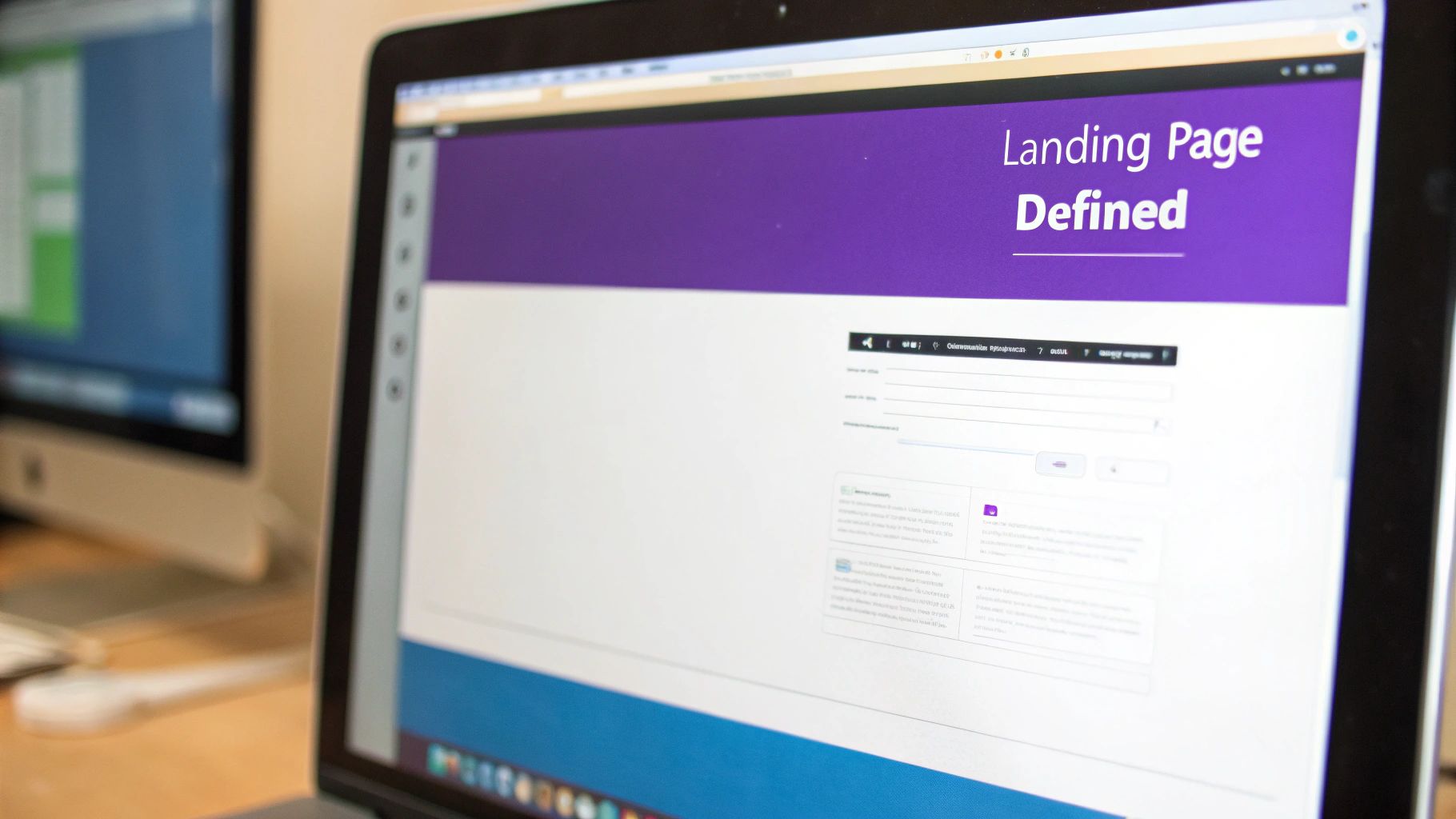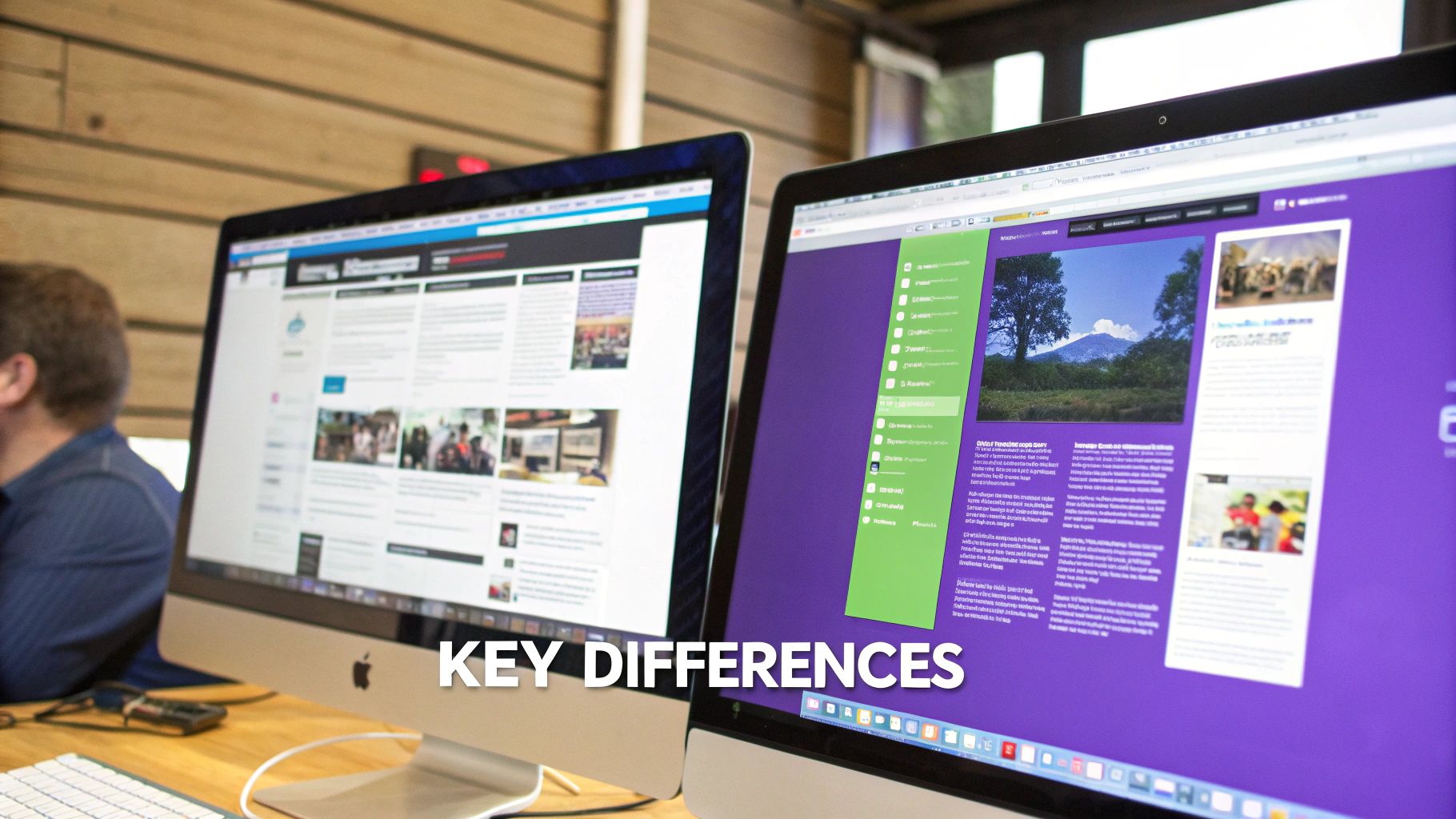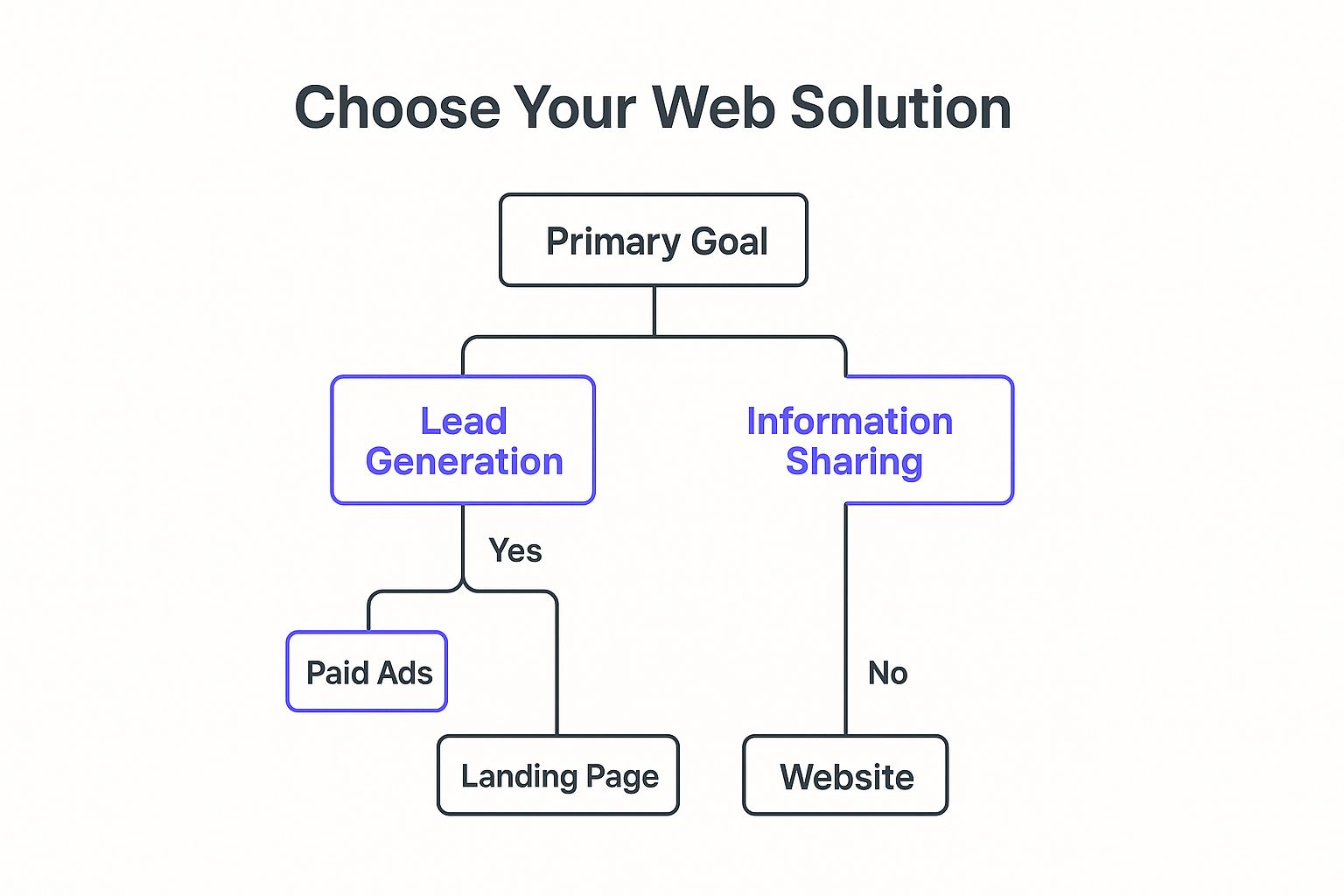Landing Page vs Website: Which Strategy Wins for Your Goals

The Real Differences That Impact Your Bottom Line
Let's move past textbook definitions of "landing page vs website." Instead, let's explore the practical differences that truly affect your profits. These structural differences significantly impact user behavior and, consequently, your business results. A landing page's singular focus creates a fundamentally different user experience than a website's broader scope. This isn't just a theory; it has tangible consequences.
For instance, consider Unbounce, a popular landing page platform. The screenshot below illustrates Unbounce's emphasis on building focused, conversion-driven pages:
Unbounce highlights the core purpose of landing pages: driving specific actions. This focused design minimizes distractions and guides visitors toward the desired outcome, whether it's a trial signup or a resource download. This contrasts sharply with a website, which typically has multiple navigation options and diverse content. While this website content is valuable for brand building, it can sometimes detract from conversions.
This inherent difference in purpose influences user interaction. A landing page aims to capture leads or generate immediate sales. A website, however, serves broader purposes, such as educating prospects, building brand awareness, and offering customer support. This difference in user intent demands distinct design and content strategies.
Understanding this "landing page vs website" dynamic is key to selecting the right tool for your marketing goals. This strategic alignment significantly impacts your marketing effectiveness and return on investment. Your choice between a landing page and a website depends on your objectives, audience, and business growth stage. This nuanced understanding is crucial for achieving your desired business results.
When Landing Pages Consistently Outperform Websites
Landing pages and websites both play vital roles in a strong online presence, but they serve distinct purposes. Understanding this distinction is crucial for maximizing your marketing ROI. This difference becomes especially clear in scenarios requiring laser focus, where landing pages consistently shine.
Paid Advertising Campaigns and Lead Generation
Consider paid advertising campaigns. You're investing in driving traffic, aiming for conversions. Sending visitors to a general website, with its numerous navigation options and varied content, can dilute your message. A dedicated landing page, tailored to the specific ad campaign, offers a smoother transition and reinforces the call to action.
For instance, if you're promoting a new eBook, your landing page should spotlight that eBook—its benefits, a compelling preview, and a clear download form. This focused approach minimizes distractions and boosts conversion rates. Similarly, SpeakerStacks users employ this principle by creating dedicated landing pages for each speaking engagement, accessed via a unique QR code. This allows them to capture leads directly from presentations, converting audience attention into tangible results.
Time-Sensitive Product Launches and Promotions
Product launches and time-sensitive promotions also greatly benefit from landing pages. Creating urgency and exclusivity is paramount for these campaigns. A dedicated landing page lets you emphasize the unique value proposition, showcase limited-time offers, and simplify the purchase process. This encourages immediate action, crucial for capitalizing on launch momentum.
In contrast, directing traffic to a standard product page within a larger website risks losing potential customers amidst other navigation options and competing offers. Landing pages are essential for capturing initial interest and maximizing conversions during these vital periods. This targeted strategy consistently outperforms websites in driving immediate action and achieving campaign goals. Landing pages regularly outperform traditional websites in conversion rates, especially when designed for specific campaigns. In fact, as of Q4 2024, the median conversion rate for landing pages across all industries was 6.6%, according to an analysis of 41,000 landing pages. Traditional website conversion rates are typically much lower, often between 1% and 3%. Discover more insights into landing page conversion rates.
To illustrate the impact of landing pages across different industries, let's examine some comparative conversion data:
To further illustrate the performance differences, let’s analyze conversion rates across various sectors. The following table highlights where landing pages excel in capturing leads and driving conversions.
Landing Page vs Website Conversion Performance by Industry
Industry | Landing Page Rate | Website Rate | Performance Gap |
|---|---|---|---|
Finance | 8.2% | 2.5% | +5.7% |
SaaS | 7.5% | 2.0% | +5.5% |
E-commerce | 5.8% | 1.8% | +4.0% |
Healthcare | 6.1% | 2.2% | +3.9% |
Education | 4.9% | 1.5% | +3.4% |
This data clearly demonstrates the superior conversion power of landing pages across various sectors, particularly in finance and SaaS. The focused experience and minimized distractions contribute significantly to higher engagement and conversion rates.
Maintaining Focus While Providing Essential Information
The key to a high-performing landing page lies in balancing focused messaging with providing sufficient information. This means finding the sweet spot between being concise and being clear. Too much information can overwhelm, while too little can create uncertainty.
Successful landing pages achieve this balance through strategic information presentation, prioritizing key benefits and addressing potential objections succinctly. They leverage compelling visuals, testimonials, and trust signals to build credibility and encourage conversions. This focused approach ensures visitors get the necessary information without being distracted from the main call to action.

Why Full Websites Remain Essential Business Assets
While landing pages are excellent tools for driving immediate conversions, a full website plays a fundamentally different, and equally vital, role in achieving long-term business success. Smart companies recognize their websites as central hubs for establishing trust, educating potential customers, and nurturing ongoing relationships. This goes far beyond simply showcasing products. It’s about creating a rich digital experience that caters to a variety of needs.
Take Apple, for example. Their website isn't just a storefront. It's a powerful instrument for cultivating a strong brand identity. The image below captures how Apple uses its website to communicate brand values and showcase its product ecosystem:
Apple's website emphasizes design, innovation, and user experience—elements central to their brand. They provide in-depth product information, educational resources, and community forums, offering support throughout the customer lifecycle. This holistic approach fosters long-term loyalty and elevates Apple from a mere product vendor to a lifestyle partner.
This comprehensive strategy stands in stark contrast to the laser focus of landing pages. A landing page, by its very nature, aims for immediate conversion, typically tied to a specific marketing campaign. This concentrated approach works well for short-term goals but lacks the breadth and adaptability needed for sustained engagement.
This is precisely why comparing a landing page and a website demands a careful evaluation of your overarching business objectives. Websites are indispensable for building credibility, fostering trust, and cultivating lasting relationships with your audience. They serve as platforms for thought leadership, content marketing, and community development. These are crucial components for long-term brand growth, especially in industries with complex buying processes.
Consider how SpeakerStacks users interact with the platform. Individual speaker pages act as highly effective landing pages, capturing leads during presentations. However, the SpeakerStacks website itself performs a distinct function, building brand awareness, educating potential users on the platform’s advantages, and providing ongoing support. This synergistic relationship between landing pages and the website allows SpeakerStacks to secure immediate leads while nurturing a wider community.
Understanding this dynamic interplay is paramount for maximizing the impact of your digital presence. A strategic combination of both approaches—landing pages and websites—often yields the most powerful results. Each approach serves a specific purpose at different stages of the customer journey. This multi-faceted strategy acknowledges the distinct, yet complementary, roles that landing pages and websites play in achieving comprehensive business goals.
The Psychology Behind Focus vs. Choice in Digital Experiences

Why does minimizing choices sometimes lead to dramatically better results? It’s not simply a marketing tactic. It’s grounded in the psychology of how we make decisions. This section explores how cognitive load—the mental effort needed to process information—influences user behavior on landing pages versus websites. We'll also unpack the paradox of choice: the idea that more options can surprisingly result in less action.
Imagine a SpeakerStacks user building a landing page for a presentation. Their goal? Attendees downloading a helpful resource. A single, clear call to action minimizes the audience's cognitive load. This focused approach significantly boosts the chance of conversion.
Websites, on the other hand, are built for exploration. They offer numerous navigation paths, inherently increasing cognitive load. This can trigger decision paralysis, overwhelming users with choices and ultimately leading to inaction.
Landing Pages: Streamlined Simplicity
Visualize a visitor landing on a page with one prominent button: "Download Now." Mental processing is minimal, paving the way for a quick decision.
Websites: Navigating Complexity
Now, picture that same visitor on a website. A menu bar, sidebar navigation, and multiple calls to action compete for attention. The increased cognitive load forces the visitor to evaluate different options, potentially leading to frustration and a higher bounce rate.
Data backs this up. The number of links and offers significantly affects conversion rates. Landing pages with a single link can see a 13.5% conversion rate. Add five or more links, and that rate dips to 10.5%. Websites, with their inherent navigation and multiple offers, constantly grapple with this challenge. Learn more about landing page statistics here.
This underscores the fundamental tension between offering choices and maintaining focus in a digital experience. Understanding this psychology is essential for creating effective digital strategies, regardless of whether you opt for a landing page or a website.
Making Strategic Decisions Based on Your Business Context
The decision between a landing page and a website isn't a binary choice. It's about selecting the right tool for the job, much like a craftsman choosing between a hammer and a screwdriver. The optimal choice hinges on several factors, including your industry, the complexity of your customer journey, and your current business stage. This section provides a practical framework to guide your decision-making process.
The infographic below offers a simplified decision tree for choosing between a landing page and a website. It considers your primary goal and whether you're using paid advertising.

As the infographic shows, lead generation, particularly when combined with paid ads, often points towards landing pages. On the other hand, if your primary goal is information sharing, a website is generally the more appropriate choice. This underscores the fundamental difference: focused conversion versus comprehensive information delivery.
Aligning Your Digital Presence with Business Objectives
Imagine a startup launching a new SaaS product. Their initial objective is capturing leads. A landing page optimized for trial sign-ups becomes their primary tool. As the company matures and shifts focus to customer education and engagement, a full website becomes essential. This evolution demonstrates the context-dependent nature of choosing between a landing page and a website.
SpeakerStacks users offer a practical example of this strategic approach. During presentations, speakers utilize individual SpeakerStacks pages as targeted landing pages for lead capture. Accessed via QR codes, these pages are optimized for a single call to action, maximizing immediate conversions. The main SpeakerStacks website, however, serves a broader purpose. It cultivates brand awareness, educates potential users about the platform’s benefits, and provides ongoing support. This illustrates how a strategic combination of landing pages and a website can create a powerful, synergistic online presence.
Evaluating Your Current Digital Strategy
Critically evaluating your current digital strategy is essential for uncovering hidden opportunities and addressing potential weaknesses. Are you relying solely on a website when targeted landing pages could dramatically improve your conversion rates? Conversely, are you overusing landing pages in situations that require the depth and breadth of a full website? This objective assessment is crucial for optimizing your digital strategy and achieving your business objectives. It involves analyzing your existing marketing channels, understanding your customer journey, and pinpointing areas where a more focused or comprehensive approach would yield superior results.
This strategic alignment ensures that your digital presence effectively supports your business objectives. Recognizing these nuances allows you to dynamically adapt your digital footprint, ensuring it aligns with your current goals and stage of business. This adaptability is key to maximizing your impact and maintaining a competitive edge.
To provide further clarity, let’s examine a few real-world scenarios and the ideal digital approach for each.
To help you make the best decision for your specific needs, the following table offers strategic guidance.
Decision Matrix: Landing Page vs Website by Business Scenario
Business Scenario | Best Choice | Key Considerations | Success Metrics |
|---|---|---|---|
Launching a new product with a limited-time promotion | Landing Page | Clear call to action, concise messaging, urgency-driven design | Conversion rate, lead generation |
Building brand awareness and establishing thought leadership | Website | Content-rich articles, blog posts, case studies, SEO optimization | Website traffic, engagement metrics (time on site, bounce rate) |
Running a targeted advertising campaign for a specific product | Landing Page | Message-match between ad and landing page, streamlined conversion process | Conversion rate, cost per acquisition |
Providing ongoing customer support and resources | Website | Comprehensive FAQ section, knowledge base, contact information | Customer satisfaction, resolution time |
Promoting a webinar or online event | Landing Page | Registration form, event details, speaker information | Registration numbers, attendance rate |
Showcasing a portfolio of work or services | Website | Case studies, testimonials, detailed service descriptions | Lead generation, website traffic |
By carefully considering your business context and objectives, you can choose the most effective digital approach—landing page or website—to achieve your desired outcomes. This targeted strategy is crucial for maximizing your online impact and driving business growth.
Implementation Strategies That Deliver Real Results
A solid theoretical foundation is essential, but practical execution is what truly separates success from failure. This section dives into proven implementation strategies for your chosen approach, whether it's landing pages, a comprehensive website, or a hybrid model. We'll also explore how to avoid common pitfalls that can derail even the most promising projects.
Realistic Timeline Expectations and Resource Allocation
Implementing a landing page strategy differs significantly from developing a full-fledged website. Landing pages, with their laser focus, can often be launched rapidly. A clearly defined objective and a streamlined design contribute to shorter development timelines, sometimes within a matter of days.
Websites, on the other hand, require more extensive planning, design, and development. Their multifaceted nature often results in longer project timelines, typically ranging from several weeks to months depending on the level of complexity.
Resource allocation follows a similar trend. Landing pages generally require fewer resources, both financially and in terms of personnel. Their streamlined development process allows for efficient resource use. Website development, conversely, necessitates a greater investment across all areas, from design and content creation to technical development and ongoing maintenance.
Measuring Success: Key Performance Indicators (KPIs) and Iteration
Regardless of whether you choose landing pages or a website, measuring results is paramount. For landing pages, conversion rates are the primary focus. Tracking how many visitors complete the desired action, whether it's making a purchase or signing up, provides direct insight into campaign effectiveness. A/B testing different versions of your landing page helps optimize performance and maximize conversions.
Website success, however, involves a broader range of metrics. While conversions remain important, they're part of a bigger picture that includes website traffic, user engagement, and lead generation. Tools like Google Analytics provide crucial data insights into user behavior, enabling you to refine your website strategy based on real user interactions. The screenshot below shows an example of Google Analytics providing key data about website performance.
This Analytics dashboard shows how metrics like bounce rate and session duration can illuminate user engagement, ultimately guiding website optimization efforts. These data-driven insights allow you to pinpoint areas for improvement and maximize website effectiveness.
Iterative Improvement and User Feedback
Data provides direction, but user feedback adds valuable context. Gather user input through surveys, feedback forms, and user testing to understand how people actually experience your digital presence. This qualitative data complements quantitative analytics, revealing the why behind user behavior.
By combining these insights, you can iteratively refine your approach. Whether it's optimizing a landing page for higher conversions or improving website navigation for a smoother user experience, these adjustments ensure your digital presence delivers real value and achieves your business goals.
Your Strategic Action Plan for Digital Success

This section isn't about abstract theory; it's a practical roadmap for applying the landing page versus website principles we've discussed. Think of it as your personalized guide to making these insights work for you, complete with timelines and ways to measure your progress.
Evaluating Your Current Digital Footprint
Begin with an honest assessment of your existing online presence. If your website is your primary digital asset, identify opportunities where targeted landing pages could improve your conversion rates. For instance, if you're directing paid traffic to your homepage, consider how a dedicated landing page might improve its effectiveness.
On the other hand, if you're heavily reliant on landing pages, ask yourself if a more robust website experience could be the key to fostering stronger customer relationships and building brand loyalty.
Identifying Areas for Improvement
With a clear picture of your current digital landscape, pinpoint specific areas for improvement. This might involve optimizing existing landing pages, creating new ones for specific campaigns, or enriching your website with valuable content and resources. The key is to think strategically: how can you best align your digital presence with your overarching business goals?
Setting Realistic Timelines and Defining Success
Set realistic timelines for implementing these changes. Launching a new landing page might take a few days, while a website overhaul could take several weeks. Allocate resources accordingly, ensuring you have the necessary design, development, and content support.
Just as importantly, define your metrics for success. For landing pages, conversion rates are often the primary focus. For websites, consider broader metrics such as traffic, engagement, and lead generation.
Implementing and Iterating for Continuous Improvement
Don't wait for the "perfect" plan—start implementing your highest-impact changes immediately. Launch, learn, and iterate. Continuously monitor your performance, gathering data and user feedback. This information will inform your ongoing adjustments and maximize your digital effectiveness. This iterative process ensures your strategy stays agile and adaptable to your evolving business needs.
Ready to make your presentations powerful lead generation tools? Visit SpeakerStacks today and turn audience attention into measurable results.